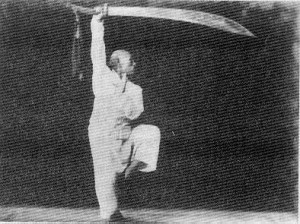Yi
/ In the Early 90's when George Xu came back from judging a tournament on the East Coast, he told us that he had been in an interesting and friendly argument with Nan Lu, a baguazhang practitioner in New York City.
In the Early 90's when George Xu came back from judging a tournament on the East Coast, he told us that he had been in an interesting and friendly argument with Nan Lu, a baguazhang practitioner in New York City.The argument was over how to describe high level Yi. Yi is most often translated "intension," but the English word doesn't do it justice. Some modern Qi jocks now use the word Yinian, generally meaning something more like "mind" but in qigong circles it simply refers to "the pathway along which you intend to send qi."
When George Xu wanted to explain to a beginning student what yi was, he would describe two Doberman-pinchers. Both were told to charge at a group of people. One dog got up close and hesitated, jumping around and barking, not sure who to bite. The other dog, the one with clear yi, immediately bit the neck of the guy with the blue shirt.
George had been arguing that one should train with "killer" yi, the mind should be focused exactly on how to kill the opponent. Nan Lu was arguing that one should have "zero" yi, a mind like a translucent sky. George wasn't willing to concede but he thought Nan Lu's argument had merit.
 A more common use of the word Yi, one that nearly all Chinese martial arts teachers use, means to have an awareness of technique. A student has yi in his form when a knowledgeable observer can see the fighting idea in the students movement. Numerous throws, joint breaks, and striking combination possibilities should be apparent.
A more common use of the word Yi, one that nearly all Chinese martial arts teachers use, means to have an awareness of technique. A student has yi in his form when a knowledgeable observer can see the fighting idea in the students movement. Numerous throws, joint breaks, and striking combination possibilities should be apparent.Every technique must have the correct force trajectories, and these must be practiced on a live partner. These trajectories themselves are also called yi. Martial arts techniques use trajectories which are vectors, arcs, and spirals. All of this is referred to as yi.
One of the magical things about a gongfu form or routine is that because the same movement can be used for many different techniques, a seasoned practitioner will develop more and more complex yi as the years go by. A single movement can have a hundred different expressions.
This seasoned and complex yi at some point starts to look less specific. With very clear yi, it looks like I'm making an upper-cut to the chin. But if I've thoroughly trained 15 different techniques for that movement I can do the movement in what we might call an undifferentiated potential state. Instead of a specific technique or fighting idea showing itself, the yi starts to look like clouds swirling around the body. It is not that you actually see the clouds, what you see is all the possibilities at once.
 Practicing at this yi level also feels like clouds, or sometimes like water, fire or mist. Once a practitioner reaches this level, she stops thinking in terms of techniques.
Practicing at this yi level also feels like clouds, or sometimes like water, fire or mist. Once a practitioner reaches this level, she stops thinking in terms of techniques.Kumar Frantzis said about Xingyi that when you strike you should be thinking "Only One Thing."
A Samurai by the old code (budo) didn't need technique, he needed only to be willing to die.
Wang Xiangzhai, one of the greatest internal martial artists of the 20th Century, said that "the yi should always be round." I'm working on it.

